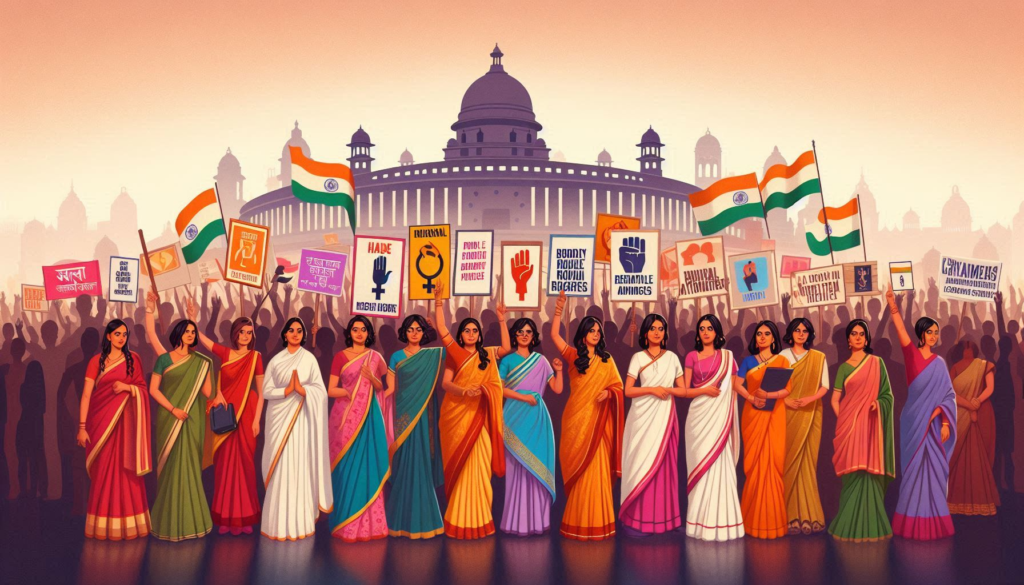
ABSTRACT
This paper examines the disconnect between the legal recognition of reproductive rights in India and their real-world implementation. While constitutional provisions and judicial decisions affirm reproductive autonomy, many individuals—especially from marginalized communities—continue to face barriers such as limited access to safe abortion, social stigma, and restrictive medical frameworks. The paper critically examines key legislations such as the MTP Amendment Act and the Surrogacy Regulation Act, calling for a shift from a medicalized to a rights-based approach. It advocates for comprehensive sex education, better healthcare access, and intersectional policy reforms to ensure the meaningful realization of reproductive rights.
INTRODUCTION
“The fight for reproductive rights in India is more than just about the law; it’s about respect, control over one’s own body, and equality between the sexes”.
Reproductive rights encompass a range of legal freedoms related to reproductive health and decision-making. These include the ability to make choices regarding reproduction without facing discrimination, coercion, or violence. This domain intersects with several fundamental rights such as the rights to equality, privacy, access to information, health, dignity, freedom from inhuman or degrading treatment, and the right to life., and considered to be an essential right concerning autonomy and equality for women In numerous pivotal cases over the last decade, Indian courts have recognized women’s reproductive rights as a fundamental aspect of the “inalienable survival rights” implicitly protected by the right to life. Despite being judicially recognized, constitutionally guaranteed, and boldly affirmed by the Court of India, reproductive rights remain unfulfilled and serve as a hindrance to the contentment of women and girls across the country.
UNDERSTANDING REPRODUCTIVE RIGHTS
Reproductive rights form an integral part of human rights and include various civil, political, economic, and social entitlements that the State is obligated to uphold. In addition to having access to comprehensive reproductive health information and services, states are required to ensure that women and girls have favorable reproductive health outcomes, such as reduced rates of unsafe abortion and maternal mortality, and the freedom to make fully informed decisions about their sexuality and reproduction without being subjected to coercion, violence, or discrimination.
The reproductive rights in India have evolved under Article 21 of the Constitution, which protects individual liberty and the right to life. Because the Supreme Court believes that these rights are essential to living a life of dignity, it has interpreted Article 21 to include the rights to privacy, physical autonomy, and reproductive choice.
Furthermore, Article 14 (right to equality before the law) and Article 15 (prohibition of discrimination on the grounds of religion, race, caste, sex, or place of birth) of the Constitution also guarantee reproductive freedom to women by way of ensuring that no woman is denied these rights based on systemic bias or socio-economic barriers. These frameworks not only make India domestically and constitutionally bound to protect and promote reproductive autonomy but also recognize its essentiality in gender equality and justice.
In addition, India has ratified several international agreements that acknowledge reproductive rights, including the Convention on the Elimination of All Forms of Discrimination Against Women (CEDAW), the International Covenant on Civil and Political Rights (ICCPR), the International Covenant on Economic, Social, and Cultural Rights (ICESCR), and the Convention on the Rights of the Child (CRC). Despite being one of the first nations in the world to create legislative and policy frameworks that ensure access to contraception and abortion, women and girls still face substantial
obstacles that prevent them from fully exercising their reproductive rights, such as subpar medical care and a lack of decision-making power for women and girls. In the Indian context, reproductive health laws and policies have traditionally prioritized demographic targets—such as population control over a rights-based framework that centers women’s autonomy and well-being. This has often resulted in approaches that are either implicitly or explicitly coercive—undermining women’s reproductive autonomy through discriminatory provisions like spousal consent requirements for access to reproductive health services
JUDICIAL RECOGNITION IN INDIA
In recent years, Indian courts have increasingly acknowledged women’s reproductive rights as a vital part of the right to life under Article 21 of the Constitution. These rights are seen as essential to women’s autonomy, dignity, and equality. In landmark judgments, the judiciary has emphasized the need to respect women’s decisions concerning pregnancy and reproductive health, thereby affirming their bodily integrity.
A key case in this evolution is Suchita Srivastava and Another v. Chandigarh Administration (2009)1, where the Supreme Court held that reproductive autonomy is a fundamental right. The Court ruled that a woman who is an adult and mentally sound has the full right to decide whether or not to continue a pregnancy. Forcing an abortion, in such cases, would violate her right to privacy and personal liberty. This ruling marked a pivotal moment in advancing reproductive justice and empowering women within India’s legal framework.
In recent years, the Indian judiciary has made considerable strides in protecting and expanding reproductive rights. In the case of Devika Biswas v. Union of India (2016)2. The Supreme Court criticized the hazardous and unethical practices observed in mass sterilization camps. The Court affirmed that reproductive rights extend beyond the freedom to choose; they also include the right to access clean, safe, and respectful medical care. This ruling underscored the government’s obligation to deliver high-quality healthcare, particularly to women in vulnerable communities.
More recently, in the case of X v. Principal Secretary, Health and Family Welfare Department, Government of NCT of Delhi (2022)3. The Supreme Court ruled that the right to abortion is not restricted to married women. Following this judgement, the Medical Termination of Pregnancy (MTP) Act expanded access to abortion by recognizing this right for all women, irrespective of their marital status.The judgment recognized reproductive freedom as an essential component of the constitutional guarantees of equality, dignity, and privacy. Together, these rulings demonstrate the judiciary’s increasing commitment to safeguarding reproductive autonomy as a fundamental aspect of women’s rights.

LEGISLATIVE GAPS AND POLICY CONCERNS
Despite notable legislative reforms, India’s abortion laws still fall short of ensuring genuine reproductive autonomy. The Medical Termination of Pregnancy Act,19714. India’s central abortion law lays down the legal framework under which abortions may be performed. However, under Sections 3 and 5 of the Act, a woman must obtain approval from one or more registered medical practitioners before proceeding with an abortion. This effectively places a gatekeeper between a woman and her right to make decisions about her own body. While spousal consent is not mandated, the requirement of medical approval still undermines a woman’s privacy and agency, as her decision is subject to someone else’s judgment. Though these provisions are often justified as safeguards against sex-selective abortions and to protect women’s health, they overlook the deeper issue: the law focuses almost exclusively on medical justifications, ignoring economic hardship, social stigma, or personal distress that may equally compel a woman to seek an abortion.
The Medical Termination of Pregnancy (Amendment) Act, 20215, claims to expand abortion access, yet it still prioritizes the judgment of medical professionals over a woman’s right to choose. Even in early pregnancy, a woman’s autonomy is not guaranteed; her decision must conform to medical approval. The Act restricts itself to limited medical justifications for abortion, including risks to the mother’s or child’s health, ineffective contraceptives, or other health issues, which undermines a woman’s agency.
The Surrogacy (Regulation) Act, 20216, similarly falls short of its rigid criteria. It explicitly excludes queer individuals, single persons, and others who do not fit into traditional family models, denying them the right to engage in surrogacy. Additionally, it fails to fully recognize the rights and informed consent of surrogate mothers themselves.
Laws concerning reproductive health must carefully balance a woman’s right to make autonomous decisions with the government’s responsibility to safeguard the health and well-being of both women and children.. Unsafe abortions should be avoided by raising knowledge, removing the social stigma associated with abortion, and expanding access to services.
CHALLENGES TO ACCESS
Accessing reproductive rights in India remains a challenge due to deep-rooted social, economic, and systemic barriers. Many women, especially in rural areas, face stigma, a lack of awareness, and poor healthcare infrastructure. Legal hurdles, like mandatory medical approvals for abortion, further limit autonomy. Marginalized groups—such as single women, LGBTQ+ individuals, and those from lower socio-economic backgrounds—struggle even more to access safe and legal reproductive care. Fear of judgment, financial constraints, and inadequate sex education only worsen the situation. True reproductive freedom means more than legal permission—it requires accessible, affordable, and stigma-free services for all, regardless of identity or status.
THE WAY FORWARD
To foster reproductive rights meaningfully, India must adopt a multifaceted approach concentrated on autonomy, accessibility, and awareness. First, actions should be taken to increase public awareness of human rights and to counteract all forms of dismantling myths, stigma, and discrimination, especially through media use, sex education, and information. The entire population can benefit from extensive information campaigns.
Second, equitable access to affordable and standard-quality healthcare services, especially in rural and marginalized areas, should be prioritized through public investment and community-based outreach.

Third, the Medical Termination of Pregnancy Act should be reformed to acknowledge abortion as a fundamental right of women, rather than treating it solely as a response to medical emergencies.. Reproductive health laws ought to achieve a balance between women’s reproductive autonomy and the public interest in women’s and children’s overall health. Autonomy, informed consent, and timely access should form the backbone of any legal framework.
Lastly, overarching suggestions for defending, advancing, and upholding reproductive rights.
Enhance India’s adherence to international human rights standards promptly and norms that protect, advance, and uphold the rights of people concerning their reproductive and human health. It is vital and necessary to assess and include recommendations for national indicators for the Sustainable Development Goals (SDGs) that are significant to the rights of reproductive health. All laws and regulations pertaining to reproductive health that are target-based, coercive, discriminatory, or gender-prejudiced ought to be reviewed.
CONCLUSION
While India’s constitutional framework promises equality and dignity, the lived experiences of women tell a different story when it comes to reproductive rights. Legal recognition alone is not enough—true change lies in translating those rights into accessible, affordable, and respectful healthcare. The gap between law and reality is often widest for those at the margins—Dalit women, rural communities, and adolescents. To truly empower, we must focus on implementation, awareness, and accountability. Only then can reproductive rights move from paper to practice, ensuring every individual has the freedom to make informed choices about their own body.
References
Ayush Kumar, Reproductive Rights Under Indian Constitution, (Aug. 6, 2020), https://www.tscld.com/reproductive-rights-under-the-indian-constitution.
Reproductive Rights In India: A Constitutional And Legal Perspective » Lawful Legal, (Apr. 17, 2025), https://lawfullegal.in/reproductive-rights-in-india-a-constitutional-and-legal-perspective/.
Rupali Kumari, Suchita Srivastava vs Chandigarh Administration, Law Times Journal (Oct. 7, 2020), https://lawtimesjournal.in/suchita-srivastava-vs-chandigarh-administration/.
https://share.google/vTw6tYTx6GFrk6wVM.
Footnotes
- Suchita Srivastava & Anr. v. Chandigarh Administration, 9 SCC 1 (Supreme Ct. India 2009). ↩︎
- Devika Biswas v. Union of India, 10 SCC 726 (Supreme Ct. India 2016). ↩︎
- [1] X v. Principal Secretary, Health and Family Welfare Department, Government of NCT of Delhi, 10 SCC 1 (Supreme Ct. India 2022). ↩︎
- The Medical Termination of Pregnancy Act, No. 34 of 1971, Acts of Parliament, 1971 (India). ↩︎
- The Medical Termination of Pregnancy (Amendment) Act, No. 8 of 2021, Acts of Parliament, 2021 (India). ↩︎
- The Surrogacy (Regulation) Act, No. 47 of 2021, Acts of Parliament, 2021 (India). ↩︎




